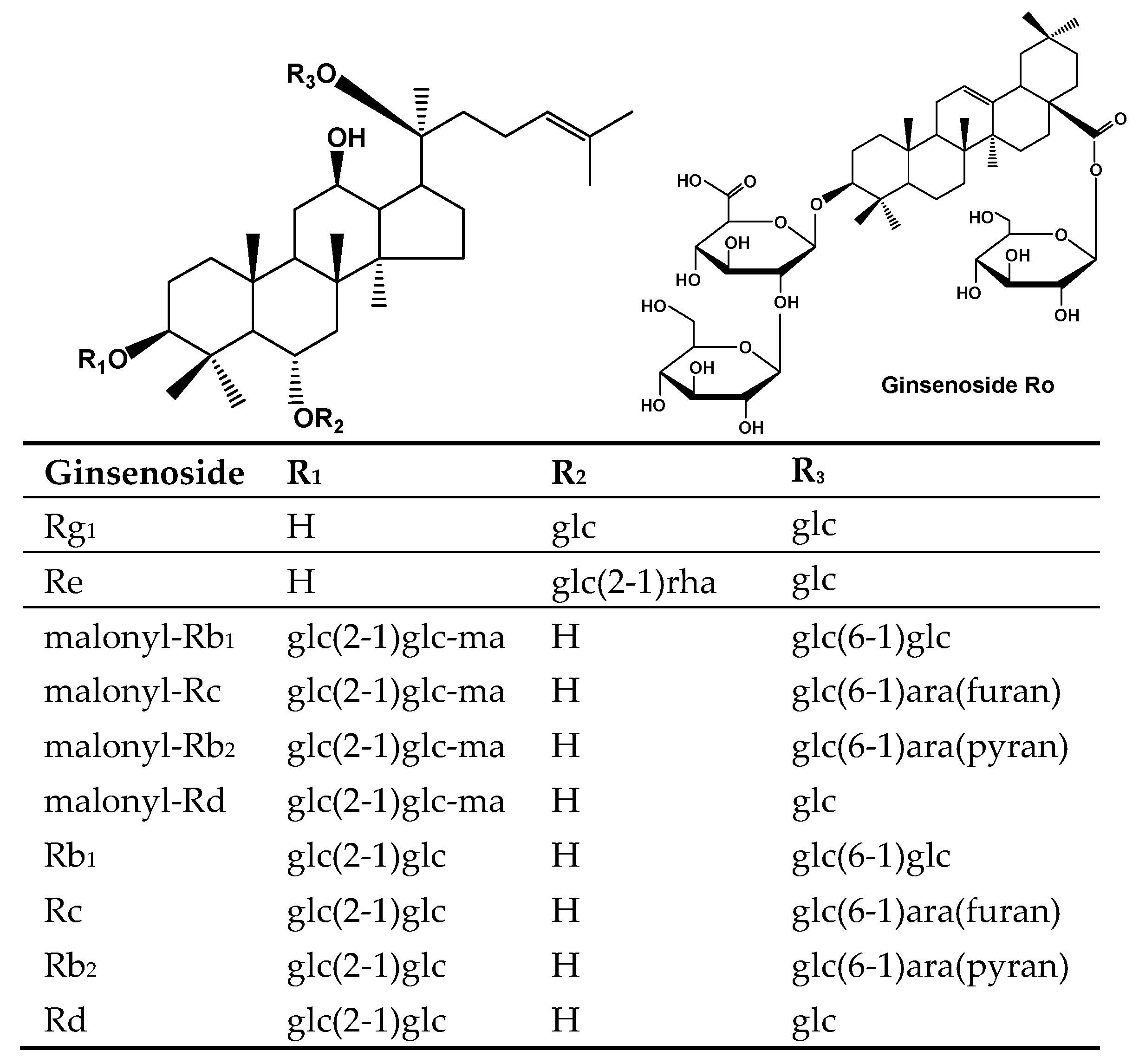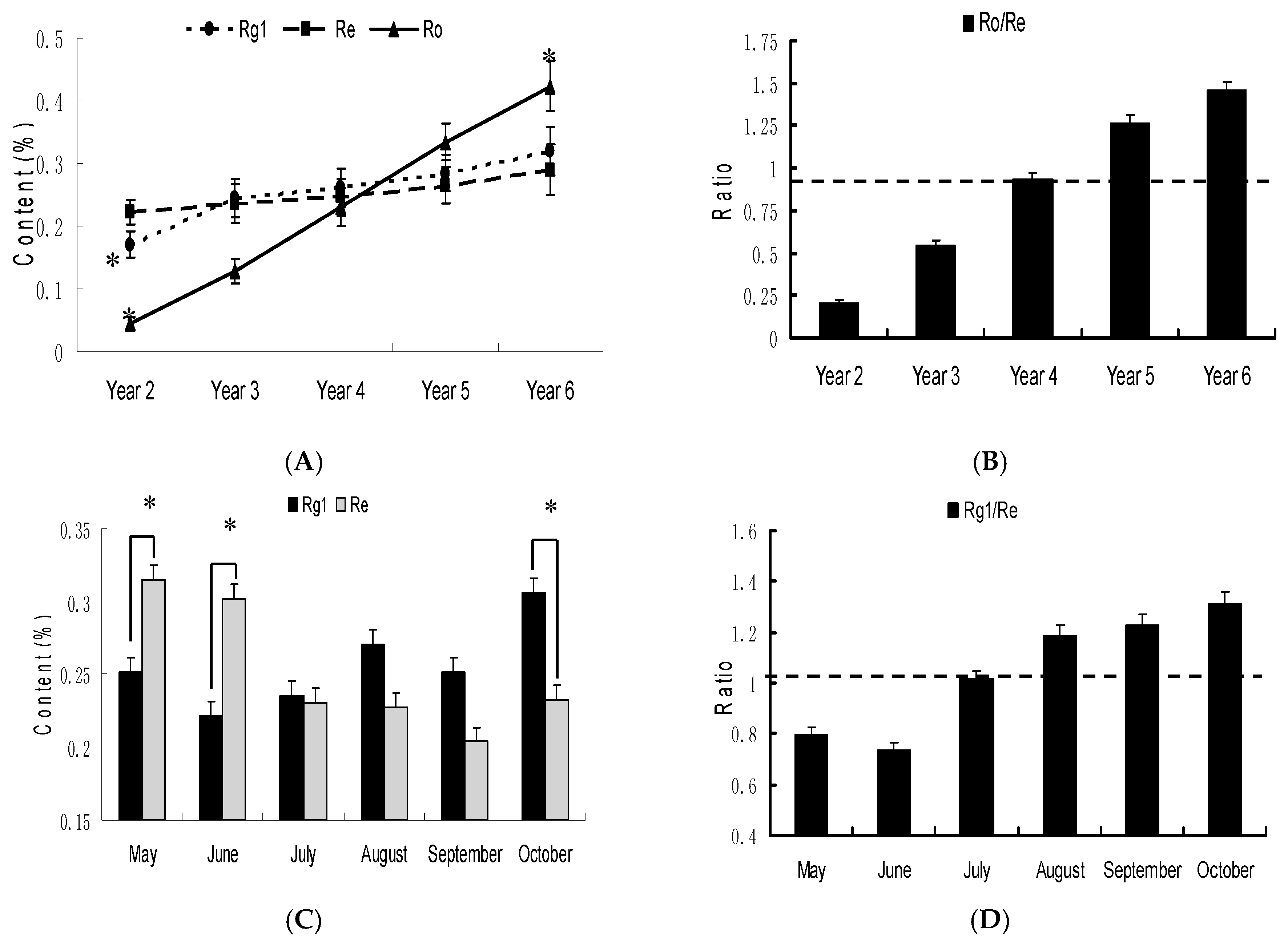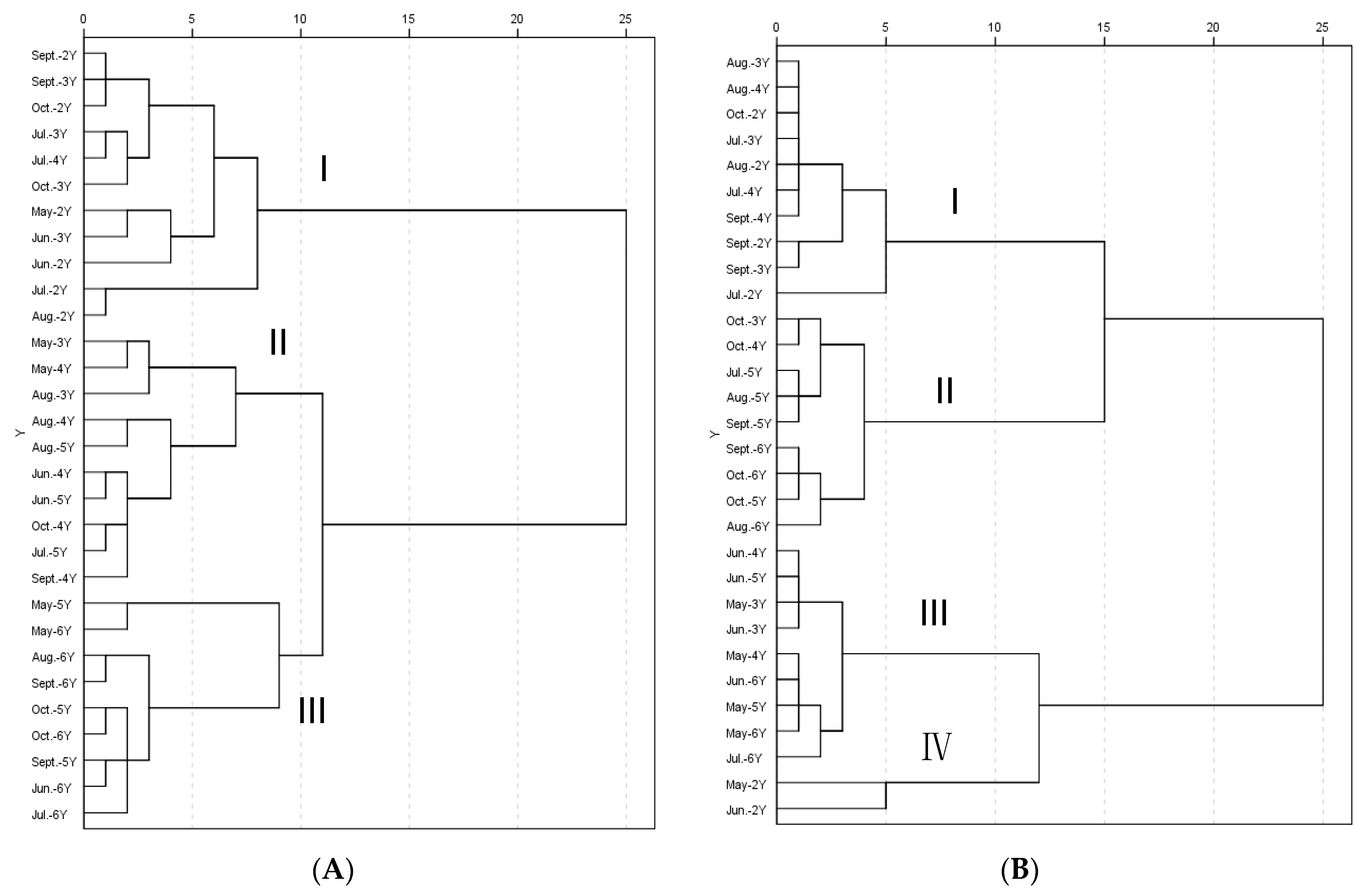Dynamic Changes in Neutral and Acidic Ginsenosides with Different Cultivation Ages and Harvest Seasons: Identification of Chemical Characteristics for Panax ginseng Quality Control
Abstract
:1. Introduction
2. Results
2.1. Method Validation
2.2. Changes of Ginsenosides in Panax ginseng at Different Cultivation Ages
2.3. Changes of Ginsenosides in Panax ginseng from Different Harvest Seasons
2.4. Hierarchical Cluster Analysis (HCA) Data
2.5. Principal Component Analysis (PCA) Data
3. Discussion
4. Materials and Methods
4.1. Chemicals
4.2. Plant Materials
4.3. Sample Preparation
4.4. High Performance Liquid Chromatographic Analysis
4.5. Multivariate Analysis
4.6. Statistical Analysis
5. Conclusions
Acknowledgments
Author Contributions
Conflicts of interest
References
- Wang, Y.T.; You, J.Y.; Yu, Y.; Qu, C.L.; Zhang, H.R.; Ding, L.; Zhang, H.Q.; Li, X.W. Analysis of ginsenosides in Panax ginseng in high pressure microwave-assisted extraction. Food Chem. 2008, 110, 161–167. [Google Scholar] [CrossRef] [PubMed]
- Park, E.H.; Kim, Y.J.; Yamabe, N.; Park, S.H.; Kim, H.K.; Jang, H.J.; Kim, J.H.; Cheon, G.J.; Ham, J.; Kang, K.S.; et al. Stereospecific anticancer effects of ginsenoside Rg3 epimers isolated from heat-processed American ginseng on human gastric cancer cell. J. Ginseng Res. 2014, 38, 22–27. [Google Scholar] [CrossRef] [PubMed]
- Xiong, Y.; Shen, L.; Liu, K.J.; Tso, P.; Xiong, Y.; Wang, G.; Woods, S.C.; Liu, M. Antiobesity and antihyperglycemic effects of ginsenoside Rb1 in rats. Diabetes 2010, 59, 2505–2512. [Google Scholar] [CrossRef] [PubMed]
- Liu, Z.; Li, W.; Li, X.; Zhang, M.; Chen, L.; Zheng, Y.N.; Sun, G.Z.; Ruan, C.C. Antidiabetic effects of malonyl ginsenosides from Panax ginseng on type 2 diabetic rats induced by high-fat diet and streptozotocin. J. Ethnopharmacol. 2013, 145, 233–240. [Google Scholar] [CrossRef] [PubMed]
- Liu, Z.Q. Chemical insights into ginseng as a resource for natural antioxidants. Chem. Rev. 2012, 112, 3329–3355. [Google Scholar] [CrossRef] [PubMed]
- Qi, L.W.; Wang, C.Z.; Yuan, C.S. Ginsenosides from American ginseng: Chemical and pharmacological diversity. Phytochemistry 2011, 72, 689–699. [Google Scholar] [CrossRef] [PubMed]
- Chuang, W.C.; Wu, H.K.; Sheu, S.J.; Chiou, S.H.; Chang, H.C.; Chen, Y.P. A comparative study on commercial samples of ginseng radix. Planta Med. 1995, 61, 459–465. [Google Scholar] [CrossRef] [PubMed]
- Liu, Z.; Li, Y.; Li, X.; Ruan, C.C.; Wang, L.J.; Sun, G.Z. The effects of dynamic changes of malonyl ginsenosides on evaluation and quality control of Panax ginseng C.A. Meyer. J. Pharm. Biomed. Anal. 2012, 64–65, 56–63. [Google Scholar] [CrossRef] [PubMed]
- Fuzzati, N. Analysis methods of ginsenosides. J. Chromatogr. B 2004, 812, 119–133. [Google Scholar] [CrossRef]
- Qi, L.W.; Wang, C.Z.; Yuan, C.S. Isolation and analysis of ginseng: Advances and challenges. Nat. Prod. Rep. 2011, 28, 467–495. [Google Scholar] [CrossRef] [PubMed]
- Court, W.A.; Hendel, J.G.; Elmi, J. Reversed-phase high performance liquid chromatographic determination of ginsenosides of Panax quinquefolium. J. Chromatogr. A 1996, 755, 11–17. [Google Scholar] [CrossRef]
- Ren, G.X.; Chen, F. Degradation of ginsenosides in American ginseng (Panax quinquefolium) extracts during microwave and conventional heating. J. Agric. Food Chem. 1999, 47, 1501–1505. [Google Scholar] [CrossRef] [PubMed]
- Shan, S.M.; Luo, J.G.; Huang, F.; Kong, L.Y. Chemical characteristics combined with bioactivity for comprehensive evaluation of Panax ginseng C.A. Meyer in different ages and seasons based on HPLC-DAD and chemometric methods. J. Pharm. Biomed. Anal. 2014, 89, 76–82. [Google Scholar] [CrossRef] [PubMed]
- Kite, G.C.; Howes, M.J.R.; Leon, C.J.; Simmonds, M.S.J. Liquid chromatography/mass spectrometry of malonyl-ginsenosides in the authentication of ginseng. Rapid Commun. Mass Spectrom. 2003, 17, 238–244. [Google Scholar] [CrossRef] [PubMed]
- Xie, Y.Y.; Luo, D.; Cheng, Y.J.; Ma, J.F.; Wang, Y.M.; Liang, Q.L.; Luo, G.A. Steaming-Induced Chemical Transformations and Holistic Quality Assessment of Red Ginseng Derived from Panax ginseng by Means of HPLC-ESI-MS/MSn-Based Multicomponent Quantification Fingerprint. J. Agric. Food Chem. 2012, 60, 8213–8224. [Google Scholar] [CrossRef] [PubMed]
- Sengupta, S.; Toh, S.A.; Sellers, L.A.; Skepper, J.N.; Koolwijk, P.; Leung, H.W.; Yeung, H.W.; Wong, R.N.S.; Sasisekharan, R.; Fan, T.P.D.; et al. Modulating angiogenesis: The yin and the yang in ginseng. Circulation 2004, 110, 1219–1225. [Google Scholar] [CrossRef] [PubMed]
- Xiao, D.; Yue, H.; Xiu, Y.; Sun, X.L.; Wang, Y.B.; Liu, S.Y. Accumulation characteristics and correlation analysis of five ginsenosides with different cultivation ages from different regions. J. Ginseng Res. 2015, 39, 338–344. [Google Scholar] [CrossRef] [PubMed]
- Lim, W.; Mudge, K.W.; Vermeylen, F. Effects of population, age, and cultivation methods on ginsenoside content of wild American ginseng (Panax quinquefolium). J. Agric. Food Chem. 2005, 53, 8498–8505. [Google Scholar] [CrossRef] [PubMed]
- Schlag, E.M.; McIntosh, M.S. Ginsenoside content and variation among and within American ginseng (Panax quinquefolius L.) populations. Phytochemistry 2006, 67, 1510–1519. [Google Scholar] [CrossRef] [PubMed]
- Wang, J.R.; Leung, C.Y.; Ho, H.M.; Chai, S.; Yau, L.F.; Zhao, Z.Z.; Jiang, Z.H. Quantitative comparison of ginsenosides and polyacetylenes in wild and cultivated American ginseng. Chem. Biodivers. 2010, 7, 975–983. [Google Scholar] [CrossRef] [PubMed]
- Shi, W.; Wang, Y.T.; Li, J.; Zhang, H.Q.; Ding, L. Investigation of ginsenosides in different parts and ages of Panax ginseng. Food Chem. 2007, 102, 664–668. [Google Scholar] [CrossRef]
- Qu, C.L.; Bai, Y.P.; Jin, X.Q.; Wang, Y.T.; Zhang, K.; You, J.Y.; Zhang, H.Q. Study on ginsenosides in different parts and ages of Panax quinquefolius L. Food Chem. 2009, 115, 340–346. [Google Scholar] [CrossRef]
- Okada, T.; Afendi, F.M.; Altaf-Ul-Amin, M.; Takahashi, H.; Nakamura, K.; Kanaya, S. Metabolomics of medicinal plants: The importance of multivariate analysis of analytical chemistry data. Curr. Comput. Aided Drug Des. 2010, 6, 179–196. [Google Scholar] [CrossRef] [PubMed]
- Park, H.E.; Lee, S.Y.; Hyun, S.H.; Kim, D.Y.; Marriott, P.J.; Choi, H.K. Gas Chromatography/Mass Spectrometry-Based Metabolic Profiling and Differentiation of Ginseng Roots According to Cultivation Age Using Variable Selection. J. AOAC Int. 2013, 96, 1266–1272. [Google Scholar] [CrossRef] [PubMed]
- Kim, N.; Kim, K.; Choi, B.Y.; Lee, D.; Shin, Y.S.; Bang, K.H.; Cha, S.W.; Lee, J.W.; Choi, H.K.; Jang, D.S.; et al. Metabolomic Approach for Age Discrimination of Panax ginseng Using UPLC-Q-Tof MS. J. Agric. Food Chem. 2011, 59, 10435–10441. [Google Scholar] [CrossRef] [PubMed]
- Yang, S.O.; Shin, Y.S.; Hyun, S.H.; Cho, S.; Bang, K.H.; Lee, D.; Choi, S.P.; Choi, H.K. NMR-based metabolic profiling and differentiation of ginseng roots according to cultivation ages. J. Pharm. Biomed. Anal. 2012, 58, 19–26. [Google Scholar] [CrossRef] [PubMed]
- Zhang, X.H.; Xu, X.X.; Xu, T. Ginsenoside Ro suppresses interleukin-1 β-induced apoptosis and inflammation in rat chondrocytes by inhibiting NF-κB. Chin. J. Nat. Med. 2015, 13, 283–289. [Google Scholar] [CrossRef]
- Murata, K.; Takeshita, F.; Samukawa, K.; Tani, T.; Matsuda, H. Effects of ginseng rhizome and ginsenoside Ro on testosterone 5α-reductase and hair re-growth in testosterone-treated mice. Phytother. Res. 2012, 26, 48–53. [Google Scholar] [CrossRef] [PubMed]
- Li, S.P.; Zhao, J.; Yang, B. Strategies for quality control of Chinese medicines. J. Pharm. Biomed. Anal. 2011, 55, 802–809. [Google Scholar] [CrossRef] [PubMed]
- Chung, I.M.; Kim, J.W.; Seguin, P.; Jun, Y.M.; Kim, S.H. Ginsenosides and phenolics in fresh and processed Korean ginseng (Panax ginseng C.A. Meyer): Effects of cultivation location, year, and storage period. Food Chem. 2012, 130, 73–83. [Google Scholar] [CrossRef]
- Lee, M.J.; Choi, J.S.; Cha, S.W.; Lee, K.S.; Lee, Z.W.; Hwang, G.S.; Lee, S.H.; Kamal, A.H.M.; Jung, Y.A.; Seung, N.S.; et al. Variation in the ginsenoside profiles of cultivated ginseng (Panax ginseng C.A. Meyer) landraces in Korea. Process Biochem. 2011, 46, 258–264. [Google Scholar] [CrossRef]
- Yap, K.Y.L.; Chan, S.Y.; Lim, C.S. Authentication of traditional Chinese medicine using infrared spectroscopy: Distinguishing between ginseng and its morphological fakes. J. Biomed. Sci. 2007, 14, 265–273. [Google Scholar] [CrossRef] [PubMed]
- Kim, N.; Kim, K.; Lee, D.; Shin, Y.S.; Bang, K.H.; Cha, S.W.; Lee, J.W.; Choi, H.K.; Hwang, B.Y.; Lee, D. Nontargeted metabolomics approach for age differentiation and structure interpretation of age-dependent key constituents in hairy roots of Panax ginseng. J. Nat. Prod. 2012, 75, 1777–1784. [Google Scholar] [CrossRef] [PubMed]
- Sumner, L.W.; Mendes, P.; Dixon, R.A. Plant metabolomics: Large-scale phytochemistry in the functional genomics era. Phytochemistry 2003, 62, 817–836. [Google Scholar] [CrossRef]
- Song, H.H.; Moon, J.Y.; Ryu, H.W.; Noh, B.S.; Kim, J.H.; Lee, H.K.; Oh, S.R. Discrimination of white ginseng origins using multivariate statistical analysis of data sets. J. Ginseng Res. 2014, 38, 187–193. [Google Scholar] [CrossRef] [PubMed]
Sample Availability: Samples of the 11 compounds are available from the authors. |






| Sample | Ginsenoside Content a (%) | Rg1/Re | Ro/Re | |||
|---|---|---|---|---|---|---|
| Month | Year | Rg1 | Re | Ro | ||
| 2 | 0.156 | 0.280 | 0.016 | 0.557 | 0.057 | |
| 3 | 0.251 | 0.316 | 0.072 | 0.794 | 0.228 | |
| May | 4 | 0.270 | 0.320 | 0.169 | 0.844 | 0.528 |
| 5 | 0.278 | 0.328 | 0.238 | 0.848 | 0.726 | |
| 6 | 0.301 | 0.330 | 0.331 | 0.912 | 1.003 | |
| 2 | 0.096 | 0.291 | 0.021 | 0.330 | 0.072 | |
| 3 | 0.228 | 0.296 | 0.101 | 0.770 | 0.341 | |
| June | 4 | 0.253 | 0.301 | 0.215 | 0.841 | 0.714 |
| 5 | 0.256 | 0.303 | 0.293 | 0.845 | 0.967 | |
| 6 | 0.276 | 0.316 | 0.364 | 0.873 | 1.152 | |
| 2 | 0.133 | 0.192 | 0.016 | 0.693 | 0.083 | |
| 3 | 0.228 | 0.205 | 0.145 | 1.112 | 0.707 | |
| July | 4 | 0.226 | 0.212 | 0.217 | 1.066 | 1.034 |
| 5 | 0.283 | 0.239 | 0.310 | 1.184 | 1.297 | |
| 6 | 0.308 | 0.306 | 0.421 | 1.007 | 1.376 | |
| 2 | 0.215 | 0.202 | 0.038 | 1.064 | 0.188 | |
| 3 | 0.244 | 0.209 | 0.142 | 1.167 | 0.679 | |
| August | 4 | 0.245 | 0.211 | 0.253 | 1.161 | 1.199 |
| 5 | 0.289 | 0.237 | 0.366 | 1.219 | 1.544 | |
| 6 | 0.358 | 0.278 | 0.486 | 1.288 | 1.748 | |
| 2 | 0.197 | 0.164 | 0.073 | 1.201 | 0.445 | |
| 3 | 0.209 | 0.168 | 0.103 | 1.244 | 0.613 | |
| September | 4 | 0.256 | 0.196 | 0.240 | 1.306 | 1.224 |
| 5 | 0.265 | 0.240 | 0.405 | 1.104 | 1.688 | |
| 6 | 0.331 | 0.251 | 0.491 | 1.319 | 1.956 | |
| 2 | 0.226 | 0.203 | 0.103 | 1.113 | 0.507 | |
| 3 | 0.310 | 0.227 | 0.207 | 1.366 | 0.912 | |
| October | 4 | 0.312 | 0.236 | 0.286 | 1.322 | 1.212 |
| 5 | 0.337 | 0.241 | 0.396 | 1.398 | 1.643 | |
| 6 | 0.343 | 0.257 | 0.446 | 1.335 | 1.735 | |
| No. | Age (Year) | Date |
|---|---|---|
| 1 | 12 May | |
| 2 | 15 June | |
| 3 | Two | 18 July |
| 4 | 16 August | |
| 5 | 19 September | |
| 6 | 21 October | |
| 7 | 12 May | |
| 8 | 15 June | |
| 9 | Three | 18 July |
| 10 | 16 August | |
| 11 | 19 September | |
| 12 | 21 October | |
| 13 | 12 May | |
| 14 | 15 June | |
| 15 | Four | 18 July |
| 16 | 16 August | |
| 17 | 19 September | |
| 18 | 21 October | |
| 19 | 12 May | |
| 20 | 15 June | |
| 21 | Five | 18 July |
| 22 | 16 August | |
| 23 | 19 September | |
| 24 | 21 October | |
| 25 | 12 May | |
| 26 | 15 June | |
| 27 | Six | 18 July |
| 28 | 16 August | |
| 29 | 19 September | |
| 30 | 21 October |
© 2017 by the authors. Licensee MDPI, Basel, Switzerland. This article is an open access article distributed under the terms and conditions of the Creative Commons Attribution (CC BY) license (http://creativecommons.org/licenses/by/4.0/).
Share and Cite
Liu, Z.; Wang, C.-Z.; Zhu, X.-Y.; Wan, J.-Y.; Zhang, J.; Li, W.; Ruan, C.-C.; Yuan, C.-S. Dynamic Changes in Neutral and Acidic Ginsenosides with Different Cultivation Ages and Harvest Seasons: Identification of Chemical Characteristics for Panax ginseng Quality Control. Molecules 2017, 22, 734. https://doi.org/10.3390/molecules22050734
Liu Z, Wang C-Z, Zhu X-Y, Wan J-Y, Zhang J, Li W, Ruan C-C, Yuan C-S. Dynamic Changes in Neutral and Acidic Ginsenosides with Different Cultivation Ages and Harvest Seasons: Identification of Chemical Characteristics for Panax ginseng Quality Control. Molecules. 2017; 22(5):734. https://doi.org/10.3390/molecules22050734
Chicago/Turabian StyleLiu, Zhi, Chong-Zhi Wang, Xing-You Zhu, Jin-Yi Wan, Jing Zhang, Wei Li, Chang-Chun Ruan, and Chun-Su Yuan. 2017. "Dynamic Changes in Neutral and Acidic Ginsenosides with Different Cultivation Ages and Harvest Seasons: Identification of Chemical Characteristics for Panax ginseng Quality Control" Molecules 22, no. 5: 734. https://doi.org/10.3390/molecules22050734







